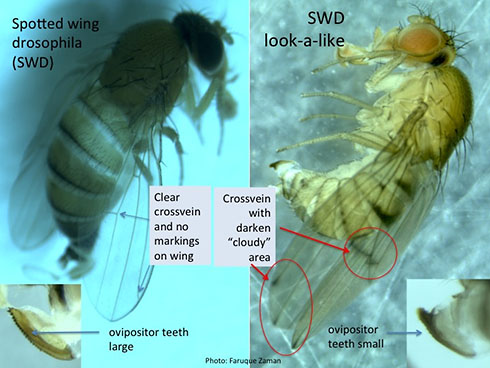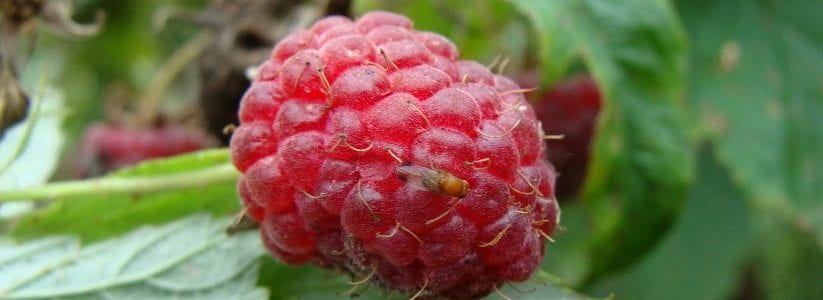The Hudson Valley Lab will be hosting a workshop and webinar on SWD, 1:30-3:00 PM, Tuesday, July 16, 2013. The Lab is located at 3357 Route 9W, Highland, NY. Commercial growers, Extension Educators and Master Gardener Coordinators are invited to attend or join the webinar to learn about this invasive insect, its production implications and control options in organic and conventional fruit plantings. The program is free but please RSVP to Mike Fargione by 7/15/2013 to 845-691-7117 or mjf22@cornell.edu.
Columbia County – first report
The week of July 8, two female SWD were captured in a trap containing a vinegar drowning solution with yeast-bait located just outside a pome and stone fruit orchard in Columbia County, as reported by Mike Fargione, Extension Educator, Eastern NY Horticulture Program, Cornell Cooperative Extension. Cherry harvest is nearing or at completion. (Accumulated GDD 1193, day length 14:52)
SWD alerts!
Rhode Island, Connecticut, Massachusetts, and lower Hudson Valley of New York are reporting evidence of SWD in fruit and sustained and increased numbers of SWD in traps. In Rhode Island, Heather Faubert reports rearing SWD from raspberries that were collected on June 24 and weekly trap catch on July 8 of 135 SWD in 3 traps set in raspberries and 14 SWD in two traps set in blueberries. In Connecticut, on July 6 Mary Conklin reports SWD found in raspberries and in traps set in blueberries and brambles. In Massachusetts, Sonia Schloemann reports modest increases in trap captures, from 2 females and 1 male the week of June 24th to 6 females and 1 male the week of July 1st with 20% of trap locations catching SWD. Most traps are in border areas of blueberry or raspberry and one capture was from a trap in sweet cherry. In the lower Hudson Valley of NY, Peter Jentsch reports observations of fruit fly oviposition in raspberry fruit (2 out of 25, 8%, fruit affected) in a sprayed planting and oviposition in sweet cherry fruit (14 out of 20, 70%, fruit affected) in an unsprayed orchard. Although SWD identity cannot be confirmed from egg morphology, it is probable this is from SWD. Time to consider management options.
Yates County – first report
Two SWD males, no females, were caught in a trap collected by Johanna Elsensohn, Research Support Specialist, Greg Loeb's lab, on July 5, 2013 in Yates County. The trap was located in the interior of a blueberry plantation. Nearby traps in sweet cherries and the wooded edge did not catch any SWD. (Accumulated GDD 1001, day length 15:09)
Ulster County – first report
Two female SWD caught in Ulster County as reported on June 24, 2013, by Jim O’Connell, Eastern NY Horticulture Team, Cornell Cooperative Extension. One was caught in a trap placed in a blackberry plantation, the other in a trap in the adjacent woods. (Accumulated GDD 834, day length 15:09)
St. Lawrence County – look alikes
Imposters! The several possible spotted wing drosophila (SWD) females found in traps collected June 22-23 in St. Lawrence County, as reported on June 24, 2013, by Paul Hetzler, Cornell Cooperative Extension Association of St. Lawrence County, were SWD look-alikes. Paul monitors a trap network mainly located in berry crops. Peter Jentsch's and Julie Carroll's programs verified the specimens were not SWD.

Suffolk County NY – first report
Five female and two male spotted wing drosophila (SWD) were caught in three traps the week of June 12-19, 2013, in eastern Long Island as reported by Faruque U. Zaman, Cornell Cooperative Extension of Suffolk County, Long Island Horticultural Research and Extension Center. Two traps were in a raspberry plantation at early ripening and one trap was 75 ft. inside the adjacent wooded area. No SWD oviposition or larvae were found after checking ripe raspberry samples from the plantation. (Accumulated GDD 650, day length 15:07)

RI first report
The first SWD of the season was confirmed on June 19, 2013 by Heather Faubert, University of Rhode Island. A single male was caught in an apple cider vinegar/yeast insert dual trap set up in a cherry tree in Newport County, Rhode Island. Cherries were collected to check for oviposition. (Accumulated GDD 508, day langth 15:08)
Orange County, NY – first report
On 17 June, 2013, 4 female and 1 male SWD were collected from two apple cider vinegar traps in Orange County, NY and identified by Peter Jentsch, entomologist, Hudson Valley Laboratory, Cornell University. The male was caught in the trap on the wooded edge, the females were caught in traps placed in a raspberry planting with fruit starting to show color. Fruit will be collected on June 21 and assessed for SWD injury level. (Accumulated GDD 640, day length 15:05)
CT first report
On June 17, 2013, a single female SWD was found in the SWD trap network maintained by Mary Concklin, Extension Educator - Fruit Production & IPM, University of Connecticut. The trap was in a cherry orchard in Hartford County, CT. Cherries had no evidence of SWD larvae.

